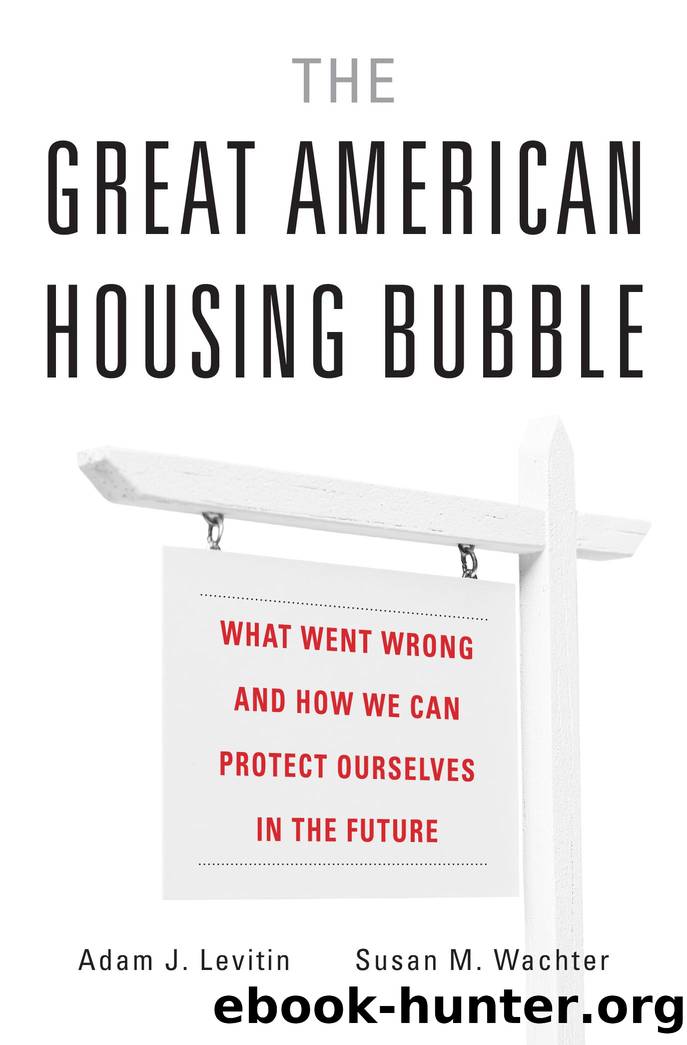The Great American Housing Bubble by What Went Wrong & How We Can Protect Ourselves in the Future

Author:What Went Wrong & How We Can Protect Ourselves in the Future
Language: eng
Format: epub
Publisher: Harvard University Press
The ABX Indices
It was possible, starting in 2006, for investors to go short on the mortgages derivatively by taking a position on the ABX, a series of indices that track the pricing of CDS written on PLS.74 CDS pricing in the dealer market had been opaque, and because CDS involved counterparty risk, they were bespoke and seldom traded. The ABX was supposed to provide a transparent measure of pricing of risk on PLS than the dealer market, as well as a more liquid, tradable asset in which investors could express both long and short positions. In other words, the ABX was designed to complete the incomplete housing market both addressing informational problems and simultaneously creating an investment vehicle to act on that information. Yet even if it had worked perfectly, the ABX would have been reflecting not just the risk on PLS, but also the counterparty risk in the CDS market.
The ABX failed to deliver on its promise. In its first year, 2006, there was no significant movement of the ABX, despite the growing risk apparent in house price declines in mid-2006 and the rise in early defaults. That is, the cost of insurance against defaults was static, even as risk, including counterparty risk, was increasing. The obvious reason for the lack of movement in the ABX was the continued sale of CDS protection on PLS at prices unrelated to risk.
On July 10, 2007, the rating agencies announced the first mass downgrade of subprime PLS. The ABX indices began a dramatic descent, and CDS spreads soared, as the entire market could see the risk rising, not just the smart money, and the synthetic CDO marketâand demand for long positions on CDS collapsed.75 The ABX indices ended up being reactive, rather than predictive.
An information failure enabled the inflation of the housing bubble, and once investors did catch on, the incomplete nature of the housing finance market meant that their attempts to go short on PLS increased counterparty risk through the growing CDS market making the entire market more leveraged and fragile. This is the fundamental market failure underlying the Great American Housing Bubble. We now turn to the question of what has been done to remedy this market failure since the bubble burst.
Download
This site does not store any files on its server. We only index and link to content provided by other sites. Please contact the content providers to delete copyright contents if any and email us, we'll remove relevant links or contents immediately.
International Integration of the Brazilian Economy by Elias C. Grivoyannis(76460)
The Radium Girls by Kate Moore(11651)
Turbulence by E. J. Noyes(7733)
Nudge - Improving Decisions about Health, Wealth, and Happiness by Thaler Sunstein(7273)
The Black Swan by Nassim Nicholas Taleb(6792)
Rich Dad Poor Dad by Robert T. Kiyosaki(6205)
Pioneering Portfolio Management by David F. Swensen(6093)
Man-made Catastrophes and Risk Information Concealment by Dmitry Chernov & Didier Sornette(5687)
Zero to One by Peter Thiel(5517)
Secrecy World by Jake Bernstein(4418)
Millionaire: The Philanderer, Gambler, and Duelist Who Invented Modern Finance by Janet Gleeson(4127)
The Age of Surveillance Capitalism by Shoshana Zuboff(4007)
Skin in the Game by Nassim Nicholas Taleb(3993)
The Money Culture by Michael Lewis(3873)
Bullshit Jobs by David Graeber(3860)
Skin in the Game: Hidden Asymmetries in Daily Life by Nassim Nicholas Taleb(3744)
The Dhandho Investor by Mohnish Pabrai(3581)
The Wisdom of Finance by Mihir Desai(3542)
Blockchain Basics by Daniel Drescher(3345)
